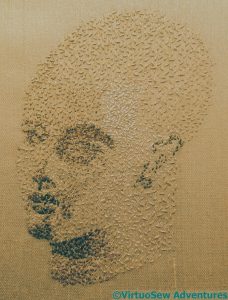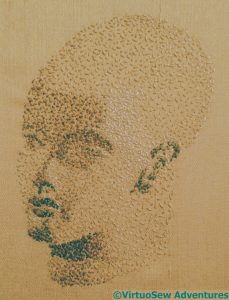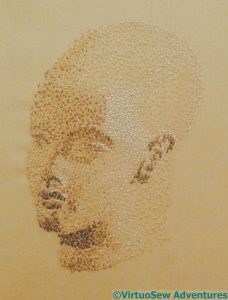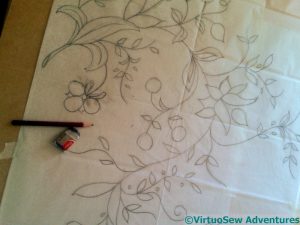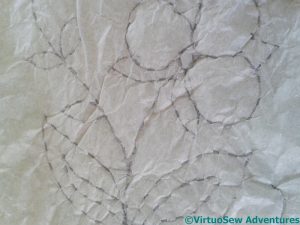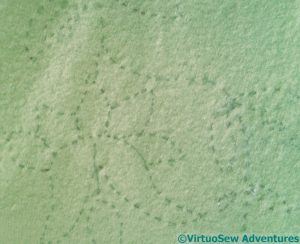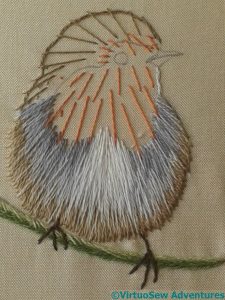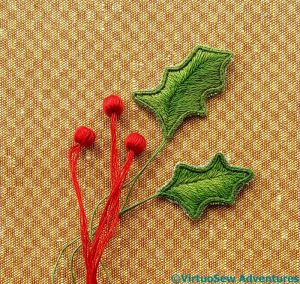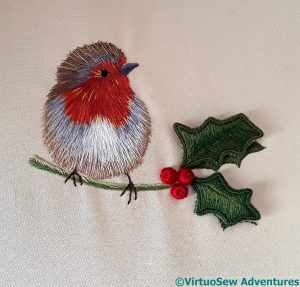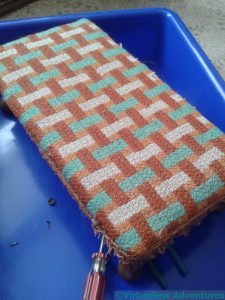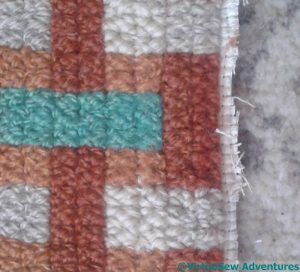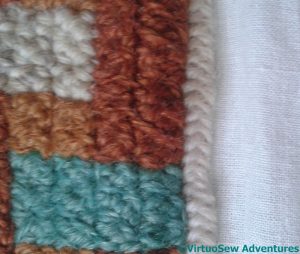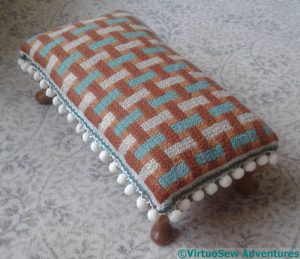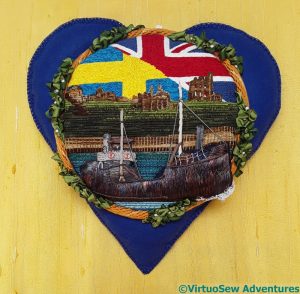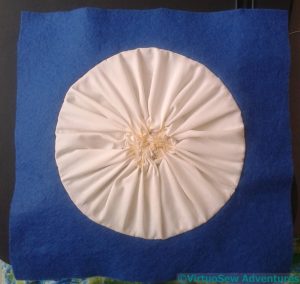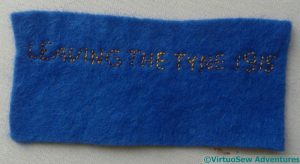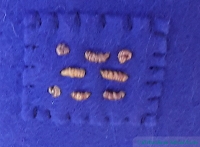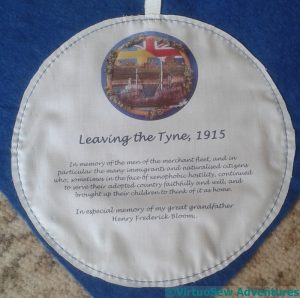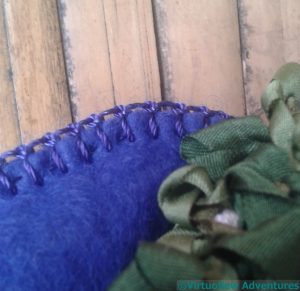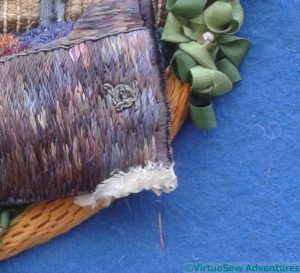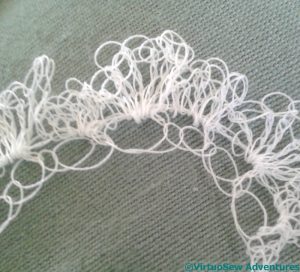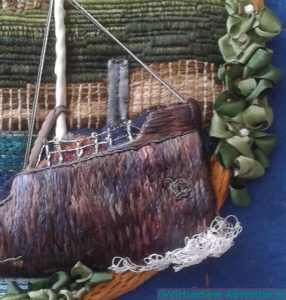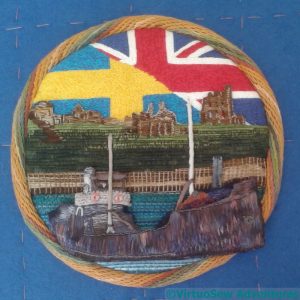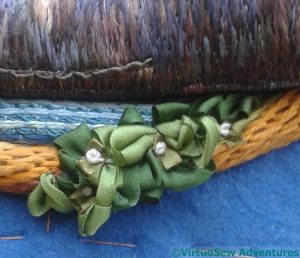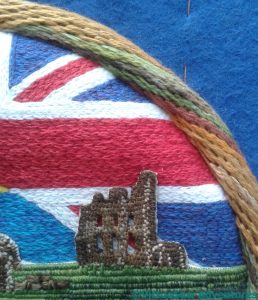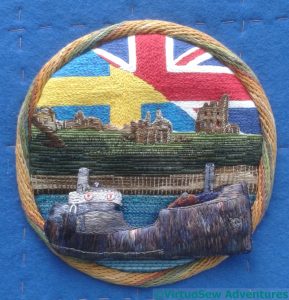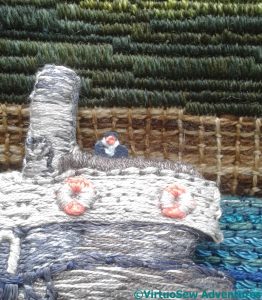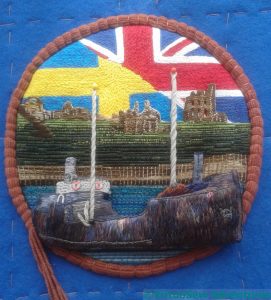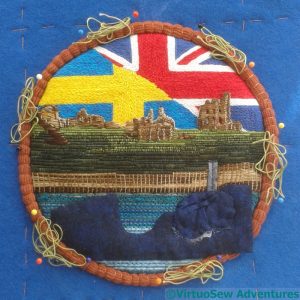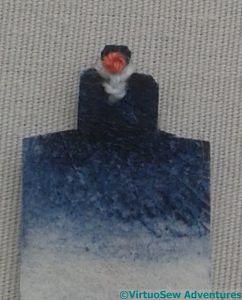Category: General Embroidery
Head of Ankhsenpaaten – more progress
Once I had a single layer of stitches I removed the running stitch outline. Not as easy as you might hope, because my “real” stitching had caught some of them, but doesn’t it look better without!
The angle of the photo shows but doesn’t over-emphasize the slightly elongated skull the family had, and you can almost see this little girl as a daughter of Nefertiti – the same fine-drawn features, softened by youth and lack of care.
The next thing to do was to add in some of the mid tone darks. The photograph I’m working from does have some quite strong shading, and I felt that in spite of my early Dark darks, there wasn’t quite enough form.
However, this point I had a bit of a wobble, because I was wondering whether I’d done too much dark. Looking at the photo, I now think not, but I do need a mid-mid-tone to blend in the curves of the face a little bit more.
However, I put in more lights to help myself back on track.
You can see, if you click to enlarge the photo, very light cream stitches around the highlight on the temple, on the eyelid and around the curve of the nostril and the light areas around the lips.
I need to extend some of these, and add those pesky mid-mid-tones. But I do think it’s going to work.
And I’m completely astonished at myself. I’ve approached this almost as I approach a watercolour, and you wouldn’t have thought embroidery – certainly not my embroidery – would be amenable to such treatment.
Gosh.
The Jacobean Coat – getting started
This is going to be a truly multi-generational project. The design elements are stolen from a tablecloth my Grandmama did during the war, and I’m going to embroider it on a coat for my Mam (her daughter). I will write a post about Grandmama’s tablecloth one of these days, because it’s an absolute cracker, full of wonderful needlelace patterns I’ve never seen anywhere else. However, as it is stitched in white on white fabric, I will have to become a better photographer first!
You may recall that during the Great Lady’s Magazine Stitch-Off, I wrote a post about the different methods for transferring designs, particularly concentrating on their advantages and disadvantages in different circumstances. The fabric of the coat (this will be the second incarnation of this fabric!) is a pale green boiled wool. It’s dense enough to have some structure and weight, light enough to be easy to stitch (I think). You might have thought it would accept gracefully any method I chose.
However, when I thought about transferring the design, I found myself ending up with the most time consuming of the lot! Since the garment is unlikely to be washed, and rubbing may damage the surface, my options are somewhat limited. Transfer pencils spread, sometimes, if the ironing temperature is wrong, the chalks have a nasty habit of not always rubbing off when they’re wrong, and my quilter’s pencil doesn’t work on strongly textured fabrics.
So, running stitch through tissue it is, then. This will take a while…..
The Little Robin finished!
I have to admit that I have enjoyed the little Robin. Here is a halfway point, showing that while many suggest drawing direction lines for their stitches, I chose to draw with my needle instead. I found that the more helpful because it gave me a chance to gauge the overlap of each section with the next.
I’ve gathered that some tutors suggest working small sections to completion, and others in colour layers. I took the latter approach with the (I’m sure not original) refinement that sometimes I went back and did another layer in a colour I’d already done.
I also had fun with the stumpwork elements: two simple wired leaves (nothing terrifying about that, after working on the Stumpwork Violets for Dreams of Amarna!) and three berries made of beads wrapped with thread. I’ve not wrapped beads before, but as it turned out, this, too, turned out to be fairly straightforward.
And fortunately, my wandering applique scissors returned to the fold in time to be of use…
So here he is.
As you can see, even though I worked him in a hoop, and regularly made sure the fabric tension was maintained, there is a little bit of puckering. That may reflect, as much as anything else, a certain anxiety on my part. I think I will mount him on a round card and add him to the winter decoration corner when I set it up, and I should be able to ease some of the puckering then.
And – for those enquiring minds that wish to know – while I can’t say I’ve fallen in love with silk shading, we are definitely on better terms than we were!
Renovating Grandmama’s Footstool
Having been working on the Heart, I was still thinking about Grandmama, and noticing that one of the footstools she made was getting a bit shabby and buckled, I decided to renovate it…
It’s worked in tapestry wool on binca (that strange cotton matting fabric that stitching happened on at primary school – does anyone else remember it?). I think I still have, somewhere, Grandmama’s draft of the pattern on squared paper, but the best I can do for putting my hand on it is to say it is Somewhere In The House! Since I don’t have a workroom, I put the footstool in a plastic tray, which I seem to remember is sold for cleaning oven trays. I use it for wet felting and to contain messes when I’m doing things like this. The blued-steel flat-headed nails were very hard to get out, and indeed, some of them lost their heads (!) and didn’t come out. In due course they were hammered firmly back in, instead!
The binca around the edge was badly mauled by the nails, so I knew I would have to do something about that, but in the meantime, there were sections of the canvaswork that needed to be reinstated. First I washed and dried the whole thing (by hand) and then spent some time looking very hard at the stitching. More than fifty years of use have worn a few small sections, and the stitch took some identifying, but in the end, I decided it was Rice Stitch, and found a pale oatmeal tapestry wool that didn’t shout its’ newness too loudly.
Then I attached the binca to some calico and covered the join with one of the long-armed cross stitches. I wasn’t absolutely sure I had enough of the plain oatmeal colour so I alternated a needleful of each all the way around.
In the end, I had plenty left over, but I’ve said many a time before that when ekeing out assorted supplies, the trick is to Make It Look Deliberate!
I had to do that with the trim as well. Nothing in our local needlework shop was even remotely suitable so in the end I took some bobble fringing, a length of ribbon and some ricrac, and made my own!
There are one or two infelicities in the details, but it’s certainly got a good few years left in it now.
Thank you, Grandmama.
“Leaving The Tyne, 1915”
My contribution to the Embroiderers Guild 100 Hearts Project, commemorating the end of the First World War.
Dedicated to the memory of the men of the merchant fleet, and in particular the many immigrants and naturalised citizens who, sometimes in the face of xenophobic hostility, continued to serve their adopted country faithfully and well, and brought up their children to think of it as home. But in especial memory of my great grandfather Henry Frederick Bloom, who was Swedish, naturalised shortly after my Grandmama’s birth, and himself served throughout the War in the merchant fleet.
It has been allocated to the Liverpool exhibition, at Liverpool Cathedral, from September 7 until October 10.
Assembling the Heart
The assembly involved a lot of stages. I cut the backing fabric into a circle and gathered it up behind the design to provide an extra layer of protection against the hurly-burly of the stuffing.
Then I had to make a stitched title label (it also has my Guild membership number, but I forgot to take that photo!) to attach to the back. I’m really not keen on lettering in stitch…
At this point, though, I thought, I simply cannot fail to have my Morse Code signature on the back too. Morse Code was a staple of communications until well after the Second World War, so it was very much in use during the First World War..
Having attached my title and signature labels to the back piece, I printed a photo of the finished roundel, the title and the dedication onto a piece of fine cotton, within a circle, to echo the circular shape of the roundel on the front. Then I attached the cotton circle to the inside of the back piece. When the piece is finished, a circle of backstitches on the back will be all that shows that this is there, but I will know.
And so will you!
I made assurance doubly sure of the assembly by first using running stitch to assemble the two sides of the Heart, and to close it after stuffing it. Then once the Heart was stuffed and closed, I reinforced the edge by stitching around it using Antwerp Edging Stitch, which is a knotted variation of blanket stitch.
Final reveal next week…
Final Details – I hope!
My first attempt to tackle the bow wave was to shred some white silk ribbon and try to attach it to the bow. That seemed a bit too white and a bit too solid.
What it did do, however, was give me an inkling as to how tricky the attachment of the bow wave was going to be. “Fiddly” doesn’t come close! And remember, there are a lot of delicate little details already assembled, so I couldn’t be too heavy handed with the attachment, either.
Having decided something lighter was needed, I tried another experiment: freeform crochet. In this case I started by using one strand of a stranded silk, decided that even that was too heavy, and moved on to sewing cotton. I’ve done a sort of shell pattern, but varied the sizes of the shells slightly to give a bit more unevenness to the whole thing. I’ve also crocheted fairly loosely to give the right frothy effect of seafoam.
The last few tweaks here are: the addition of the bow wave, and then the addition of railings around the deck cargo on the bow, and finally the rigging. The railings are made using a paper covered wire painted silver and dirtied with inktense for the posts, and two lines of black and silver twist for the chains. They’ve been surprisingly effective in helping everything to sit at its right plane in the sequence from foreground to background.
There maybe isn’t enough rigging for an operational vessel, but the photo wasn’t clear, and there is enough to have point and purpose
Now all I have to do (all!!!) is assemble my Heart!
More on the Wreath, and Other Details
In the end I covered the twisted cord (actually a bamboo and cotton blend knitting yarn) for the mast and spars with silk ribbon, which was more than slightly fiddly to achieve. There’s a collar around the mast, which, in an echo of the lifebelts, is a loop of buttonhole stitch. That was even fiddlier (is that a word? It is now!).
And Great-Grandfather’s wheelhouse has acquired a roof, made of several layers of buckram covered in silk ribbon, with buttonhole bars for the struts holding it up. That was also fiddly!
So, on to the wreath itself. That involved three different colours of silk ribbon, in two different width. I briefly considered something like the folded “leaf” shapes using wrapped parchement you sometimes see in 17th Century work, but in the end I decided I didn’t want to create anything too formal here, because it wouldn’t match the flow of the stitching. Sometimes a formal section provides a framework for everything else to clamber over, but here I felt it would create stopping-points, interrupting the eye as it moves around the piece. So the ribbons were knotted and looped and caught down in a sort of flowing chaos. White stranded silk French Knots, representing white berries, provide subtle accent and punctuation.
As you see, the wreath is now in place, with just a few white berries – white for peace.
I have quite a few more little tweaks to make, details to emphasize, maybe a bow-wave to add, but this is the original sketch brought mostly to life, and provides me with some hope that all that thinking and working will have a good result.
Progress on the wreath
The last time I used Raised Stem Stitch Band, it was for the rim of the Crock of Gold, and it went around concentrically.
This time I wanted to create the twisting appearance of a rope frame, so there was a little trial and error involved in working out how to make it work. Here you can see that there are green sections (which will be under the wreath) and yellow sections with differing shades to help create the rope effect. It’s not the classical version that runs straight along the axis of the foundation stitches, but I think it has worked rather nicely! That’s a relief…
It is a little lumpy, perhaps, but the shades of thread do create some shaping in the rope section, and I think the wreath itself will help to enhance that.
You can begin to see that the weight of stitchery is making the fabric sag, in spite of the backing. It’s just as well I did back it!
Another close-up, this time to show Great Grandfather in his place on the bridge.
He’s tiny, of course, and many onlookers won’t even notice him. But he’s there, the one human element in the piece, standing for all the hundreds of thousands of men and women involved in the war effort, military and civilian alike.
Details to think about
While I was working on the string padding and testing the placement of the vessel section, I was able to test the placement and height of the masts.
These are too high, but they are in roughly the right place, which is a step in the right direction, at least!
And, however much I may have wished to, I can’t simply use twisted cord. I’ll have to cover the masts with something…
Leaving that point to ponder, I finished the string padding and removed the vessel section, leaving its shadow in place. You may note that I’ve added a funnel, and a bit of extra padding for the deck cargo!
I want to weave a wreath around the rope frame, in such a way as to set off the ship, rather than argue with it. The green tangles of thread helped me to do so…
Finally, I had another hard look at the photo and realised there was a watchkeeper on deck.
So here he is: buckram painted with inktense, a French knot for a face, and a knot of white thread for his scarf.
I’m going to say that this is Great-Grandfather, on watch as his ship leaves the Tyne.

